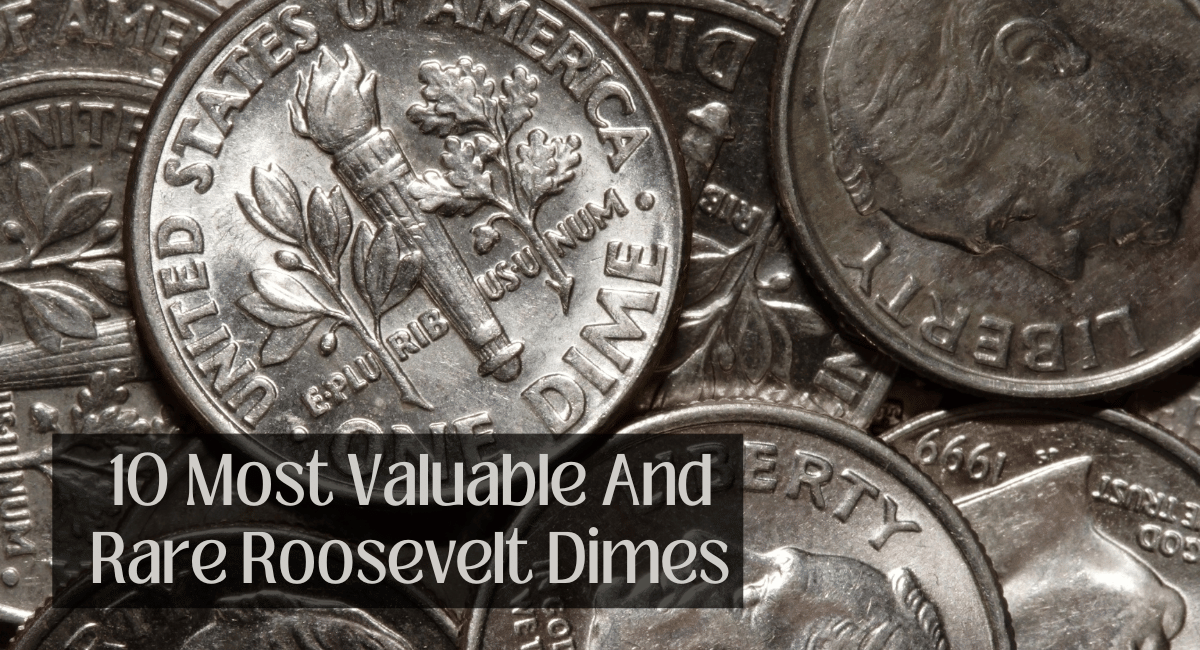The Roosevelt dime, first minted in 1946, is a ten-cent coin issued by the United States Mint. Named after President Franklin D. Roosevelt, this coin was introduced to honor his leadership and contribution, especially in the establishment of the March of Dimes program that combated polio. This coin has become a significant piece in the world of numismatics, attracting collectors due to its historical value and the variations that exist within its series.
Criteria for Valuation and Rarity
In determining the value and rarity of Roosevelt dimes, several factors are paramount:
- Mint Errors: Dimes with minting errors often attract higher values due to their uniqueness.
- Mintage Numbers: Lower mintage typically correlates with higher rarity and value.
- Condition: Coins in pristine condition (uncirculated or with minimal wear) are usually more valuable.
Top 10 Valuable and Rare Roosevelt Dimes
1949-S, 10C (MS68 Full Bands)
Background and Rarity
- The 1949-S Roosevelt dime is a remarkable coin primarily due to its rare combination of the “S” mintmark and the Full Bands designation.
- The “S” mintmark denotes its production at the San Francisco Mint, a facility known for its lower mintage figures compared to other mints.
- The MS68 grade by professional grading services like NGC or PCGS indicates that the coin is in near-perfect condition, showing no more than 4 or 5 minor blemishes under 5x magnification.
Full Bands Feature
- The Full Bands (FB) designation is critical in assessing the value of Roosevelt dimes. It refers to the distinct and full separation of the horizontal bands holding together the torch on the coin’s reverse.
- This feature is a testament to the coin’s striking quality, as it requires precise pressure and dies in good condition to achieve this level of detail.
Estimated Value and Collectibility
- The estimated value of $50,000 reflects its rarity, condition, and the demand among collectors.
- Coins from this era in such pristine condition are scarce, and the Full Bands designation adds significantly to its collectibility.
Historical Context
- The post-World War II era saw a surge in coin collecting in the United States, and the Roosevelt dime quickly became a favorite among collectors.
- The year 1949 was not particularly notable in terms of minting innovations or historical events affecting the mint, which adds to the mystery and allure of why this particular dime is so rare in such a high grade.
1968 No S Proof Dime
Background and Minting Error
- The 1968 No S Proof Dime is a fascinating example of a minting error that significantly enhances a coin’s value.
- Proof coins are specially minted with high-quality dies and treated to create a mirror-like surface. They are typically distinguished by an ‘S’ mintmark, indicating their production at the San Francisco Mint.
- However, this particular dime lacks the ‘S’ mintmark, a notable omission that makes it extremely rare.
Rarity and Value
- This error was a result of a few proof dies being accidentally shipped without the ‘S’ mintmark.
- Its rarity is underscored by the fact that only a handful of these error coins are known to exist, making them highly prized by collectors.
- The estimated value of $20,000 is influenced by its rarity and the story behind the minting error, which adds a layer of intrigue for collectors.
Collector Interest
- Error coins like the 1968 No S Proof Dime are especially popular in numismatics due to their unique stories and the circumstances of their creation.
- This coin is a highlight in any collection, not only for its monetary value but also for its uniqueness and the minting anomaly it represents.
1951-S, 10C (MS68 Full Bands)
Background and Rarity
- The 1951-S Roosevelt dime stands out due to its origin from the San Francisco Mint, denoted by the “S” mintmark.
- The MS68 grade indicates an exceptional state of preservation, with minimal blemishes visible under magnification.
- Full Bands (FB) designation is crucial in assessing this coin’s value. It implies a sharp and full strike, particularly noticeable in the horizontal bands of the torch on the coin’s reverse.
Collectibility and Value
- Estimated at $15,000, its value is reflective of both its condition and the scarcity of dimes from this year and mint with the FB designation.
- The combination of its high grade, mintmark, and Full Bands feature makes it a significant piece for collectors.
Historical Context
- 1951 was a period of relative stability in the U.S. Mint’s operations post-World War II, making the high grade of this coin more intriguing.
1949, 10C (MS68)
Quality and Rarity
- The 1949 Philadelphia Roosevelt dime is notable for its exceptional luster and minimal marks, earning an MS68 grade.
- This high grade is rare for coins from this period, indicating a remarkable state of preservation.
Estimated Value and Collector Interest
- Valued at approximately $10,000, this coin’s worth is largely due to its condition and the rarity of finding dimes from this era in such an immaculate state.
- The absence of the Full Bands designation suggests that the coin’s overall appeal lies in its luster and pristine condition.
1950-S, 10C (MS68 Full Bands)
Features and Rarity
- This dime from the San Francisco Mint is distinguished by its Full Bands, signifying a detailed and sharp strike.
- The MS68 grade underscores its exceptional condition, with barely any signs of wear or blemishes.
Value and Collectibility
- With an estimated value of $8,000, its appeal lies in the combination of its high grade, the FB designation, and its mint origin.
- The 1950-S dime is sought after due to its rarity in both condition and striking quality.
1955, 10C (MS68 Full Bands)
Rarity and Condition
- The 1955 Roosevelt dime with Full Bands and an MS68 grade is known for its rarity.
- The Full Bands designation is particularly hard to come by for coins minted in this year, making this dime highly prized.
Value and Historical Significance
- Estimated to be worth around $5,000, its value is influenced by its condition and the difficulty of finding 1955 dimes with such distinct features.
- This coin is a testament to the high-quality minting processes employed during this era.
1963, 10C (MS67+ Full Torch)
Characteristics and Significance
- The 1963 dime with the ‘Full Torch’ designation is a superb example of a well-struck coin.
- The ‘Full Torch’ refers to the clear and distinct bands on the torch’s handle, a feature that is challenging to preserve in circulation.
- Graded as MS67+, this coin falls just short of being perfect, indicating minimal imperfections under close inspection.
Value and Rarity
- Estimated at $3,500, the coin’s value reflects its excellent condition and the rarity of finding a ‘Full Torch’ designation from this year.
- 1963 was a year of substantial production of Roosevelt dimes, making high-grade examples with distinct features more sought after.
1964, 10C (MS67+ Full Bands)
Historical Context
- The 1964 Roosevelt dime is historically significant as it marks the last year of dimes containing 90% silver, a response to rising silver prices and coin hoarding.
- The shift from silver to a copper-nickel clad composition in 1965 makes this year’s dimes especially noteworthy.
Features and Collector Interest
- This coin, graded MS67+, showcases an exceptional strike and luster.
- The ‘Full Bands’ designation indicates a well-struck coin where the bands of the torch are fully and clearly separated.
- Its estimated value of $3,000 is driven by its condition, historical significance, and the end of the silver coinage era.
1975 No S Proof Dime
Minting Error and Rarity
- The 1975 No S Proof Dime is a rare error coin that lacks the ‘S’ mintmark, which should be present on proof coins from the San Francisco Mint.
- Proof coins are struck with special care for collectors, and errors in this category are highly unusual and coveted.
Value and Collectibility
- With an estimated value of $2,500, this dime is valued for its rarity and the peculiar circumstance of its minting error.
- The absence of the ‘S’ mintmark on a proof coin makes it a unique collectible, attracting significant attention in the numismatic community.
1982 No P Dime
Error and Uniqueness
- The 1982 No P Dime is noted for the omission of the ‘P’ mintmark, which should have been included to denote its production at the Philadelphia Mint.
- Such mintmark errors are rare and create a significant interest among collectors.
Collectibility and Market Value
- Its estimated value of $2,000 reflects its status as a collectible error coin.
- Collectors value this dime not just for its monetary worth but for the story and rarity that the error represents.






